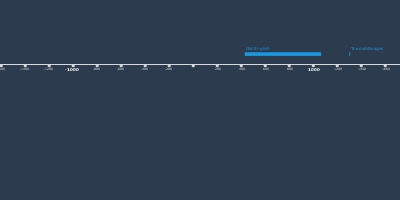The middle ages (may 2, 1066 – nov 20, 1450)
Description:
the middke ages is the time when we describe the fall between Rome and the beging of the renaissance inte 14th century. The norman invaison in 1066 the frenchman Wílliam the cnoqueer became the king of England. At that time there were abour 10.000 french words incorporated in the English language. The french language was introduced as the language court in the law.The culture started to change, the writters and artists started to lock back at the the art and the culture of Greece and Rome. The part after Romes fall was called the "dark" age, there was no scentific accomplishment that had been made, no great art produced, no great leaders was born.
The Middle Ages: The Catholic Church
After the fall of Rome, no single state or government united the people who lived on the European continent. Instead, the Catholic Church became the most powerful institution of the medieval period. Kings, queens and other leaders derived much of their power from their alliances with and protection of the Church.
(In 800 CE, for example, Pope Leo III named the Frankish king Charlemagne the “Emperor of the Romans”–the first since that empire’s fall more than 300 years before. Over time, Charlemagne’s realm became the Holy Roman Empire, one of several political entities in Europe whose interests tended to align with those of the Church.)
Ordinary people across Europe had to “tithe” 10 percent of their earnings each year to the Church; at the same time, the Church was mostly exempt from taxation. These policies helped it to amass a great deal of money and power.
The Middle Ages: The Rise of Islam
Meanwhile, the Islamic world was growing larger and more powerful. After the prophet Muhammad’s death in 632 CE, Muslim armies conquered large parts of the Middle East, uniting them under the rule of a single caliph. At its height, the medieval Islamic world was more than three times bigger than all of Christendom.
Under the caliphs, great cities such as Cairo, Baghdad and Damascus fostered a vibrant intellectual and cultural life. Poets, scientists and philosophers wrote thousands of books (on paper, a Chinese invention that had made its way into the Islamic world by the 8th century). Scholars translated Greek, Iranian and Indian texts into Arabic. Inventors devised technologies like the pinhole camera, soap, windmills, surgical instruments, an early flying machine and the system of numerals that we use today. And religious scholars and mystics translated, interpreted and taught the Quran and other scriptural texts to people across the Middle East.
Toward the end of the 11th century, the Catholic Church began to authorize military expeditions, or Crusades, to expel Muslim “infidels” from the Holy Land. Crusaders, who wore red crosses on their coats to advertise their status, believed that their service would guarantee the remission of their sins and ensure that they could spend all eternity in Heaven. (They also received more worldly rewards, such as papal protection of their property and forgiveness of some kinds of loan payments.)
The Crusades began in 1095, when Pope Urban summoned a Christian army to fight its way to Jerusalem, and continued on and off until the end of the 15th century. No one “won” the Crusades; in fact, many thousands of people from both sides lost their lives. They did make ordinary Catholics across Christendom feel like they had a common purpose, and they inspired waves of religious enthusiasm among people who might otherwise have felt alienated from the official Church. They also exposed Crusaders to Islamic literature, science and technology–exposure that would have a lasting effect on European intellectual life.
The Middle Ages: Art and Architecture
Another way to show devotion to the Church was to build grand cathedrals and other ecclesiastical structures such as monasteries. Cathedrals were the largest buildings in medieval Europe, and they could be found at the center of towns and cities across the continent.
Between the 10th and 13th centuries, most European cathedrals were built in the Romanesque style. Romanesque cathedrals are solid and substantial: They have rounded masonry arches and barrel vaults supporting the roof, thick stone walls and few windows. (Examples of Romanesque architecture include the Porto Cathedral in Portugal and the Speyer Cathedral in present-day Germany.)
Also, before the invention of the printing press in the 15th century, even books were works of art. Craftsmen in monasteries (and later in universities) created illuminated manuscripts: handmade sacred and secular books with colored illustrations, gold and silver lettering and other adornments. In the 12th century, urban booksellers began to market smaller illuminated manuscripts, like books of hours, psalters and other prayer books, to wealthy individuals.
Added to timeline:
Date:
may 2, 1066
nov 20, 1450
~ 384 years
